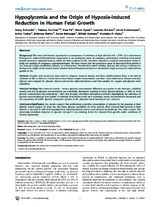Hypoglycemia and the origin of hypoxia-induced reduction in human fetal growth

View/
Date
2010-01Author
Zamudio, Stacy
Torricos, Tatiana
Fik, Ewa
Oyala, María
Echalar, Lourdes
Pullockaran, Janet
Tutino, Emily
Martin, Brittney
Belliappa, Sonia
Balanza, Elfride
Illsley, Nicholas P
Metadata
Show full item recordAbstract
Abtract.
Background: The most well known reproductive consequence of residence at high altitude (HA .2700 m) is reduction in
fetal growth. Reduced fetoplacental oxygenation is an underlying cause of pregnancy pathologies, including intrauterine
growth restriction and preeclampsia, which are more common at HA. Therefore, altitude is a natural experimental model to study the etiology of pregnancy pathophysiologies. We have shown that the proximate cause of decreased fetal growth is not reduced oxygen availability, delivery, or consumption. We therefore asked whether glucose, the primary substrate for fetal growth, might be decreased and/or whether altered fetoplacental glucose metabolism might account for reduced fetal growth at HA.
Methods: Doppler and ultrasound were used to measure maternal uterine and fetal umbilical blood flows in 69 and 58
residents of 400 vs 3600 m. Arterial and venous blood samples from mother and fetus were collected at elective cesarean
delivery and analyzed for glucose, lactate and insulin. Maternal delivery and fetal uptakes for oxygen and glucose were
calculated.
Principal Findings: The maternal arterial – venous glucose concentration difference was greater at HA. However, umbilical
venous and arterial glucose concentrations were markedly decreased, resulting in lower glucose delivery at 3600 m. Fetal
glucose consumption was reduced by .28%, but strongly correlated with glucose delivery, highlighting the relevance of
glucose concentration to fetal uptake. At altitude, fetal lactate levels were increased, insulin concentrations decreased, and
the expression of GLUT1 glucose transporter protein in the placental basal membrane was reduced.
Conclusion/Significance: Our results support that preferential anaerobic consumption of glucose by the placenta at high
altitude spares oxygen for fetal use, but limits glucose availability for fetal growth. Thus reduced fetal growth at high
altitude is associated with fetal hypoglycemia, hypoinsulinemia and a trend towards lactacidemia. Our data support that placentally-mediated reduction in glucose transport is an initiating factor for reduced fetal growth under conditions of chronic hypoxemia.
